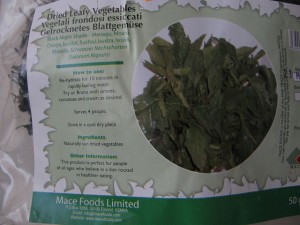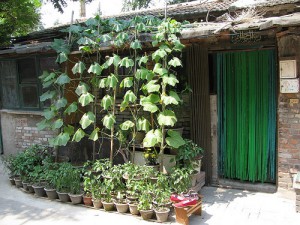![]() Great to see two papers by our friends at Bioversity come out in rapid succession recently relating to two project with which I was marginally connected in their early stages back in the 90s. One is on African leafy vegetables (ALV) ((Gotor, E., & Irungu, C. (2010). The impact of Bioversity International’s African Leafy Vegetables programme in Kenya Impact Assessment and Project Appraisal, 28 (1), 41-55 DOI: 10.3152/146155110X488817)), a common subject here. And the other on homegardens ((Galluzzi, G., Eyzaguirre, P., & Negri, V. (2010). Home gardens: neglected hotspots of agro-biodiversity and cultural diversity Biodiversity and Conservation DOI: 10.1007/s10531-010-9919-5)).
Great to see two papers by our friends at Bioversity come out in rapid succession recently relating to two project with which I was marginally connected in their early stages back in the 90s. One is on African leafy vegetables (ALV) ((Gotor, E., & Irungu, C. (2010). The impact of Bioversity International’s African Leafy Vegetables programme in Kenya Impact Assessment and Project Appraisal, 28 (1), 41-55 DOI: 10.3152/146155110X488817)), a common subject here. And the other on homegardens ((Galluzzi, G., Eyzaguirre, P., & Negri, V. (2010). Home gardens: neglected hotspots of agro-biodiversity and cultural diversity Biodiversity and Conservation DOI: 10.1007/s10531-010-9919-5)).
 The ALV paper tries to measure the impact of the work carried out starting in the mid-90s to identify and address key constraints to production and consumption. This is fairly easy to do in terms of research papers published and MSc degrees awarded, but more tricky when it comes to measuring what ALVs mean to the people who eat them. The authors tried to do this through fieldwork at four sites in Kenya. There’s no doubt there has been an increase in ALV production and marketing during the past 10 years, and a significant change in perceptions about these species, which are no longer considered simply “food for the poor.” Their presence in upmarket Nairobi supermarkets is testament to that. What still needs to be verified is that this is leading to significant nutrition and health benefits.
The ALV paper tries to measure the impact of the work carried out starting in the mid-90s to identify and address key constraints to production and consumption. This is fairly easy to do in terms of research papers published and MSc degrees awarded, but more tricky when it comes to measuring what ALVs mean to the people who eat them. The authors tried to do this through fieldwork at four sites in Kenya. There’s no doubt there has been an increase in ALV production and marketing during the past 10 years, and a significant change in perceptions about these species, which are no longer considered simply “food for the poor.” Their presence in upmarket Nairobi supermarkets is testament to that. What still needs to be verified is that this is leading to significant nutrition and health benefits.
A particularly poignant aspect of this study was the way it highlighted the importance of one person, the late Prof. James Chewya of the University of Nairobi, in driving the early ALV work, in particular by influencing young researchers to get involved. Jim is still much missed.
 The homegardens paper is less specifically tied in to the Bioversity project on this topic which began in the early 90s, being essentially a review of the literature of the past couple of decades. ((You can find a copy of the paper on Bioversity’s shiny new website.)) It rehearses the biological features of homegardens, in particular their complexity and diversity, stresses their cultural and socio-economic importance, and describes how these drive each other. The section on the future of homegardens as loci for research and conservation is especially interesting in its juxtaposition of the somewhat different roles of these intensive micro-environments in developing and high-income countries. ((I’ve removed the references in the following quotations to help the flow.))
The homegardens paper is less specifically tied in to the Bioversity project on this topic which began in the early 90s, being essentially a review of the literature of the past couple of decades. ((You can find a copy of the paper on Bioversity’s shiny new website.)) It rehearses the biological features of homegardens, in particular their complexity and diversity, stresses their cultural and socio-economic importance, and describes how these drive each other. The section on the future of homegardens as loci for research and conservation is especially interesting in its juxtaposition of the somewhat different roles of these intensive micro-environments in developing and high-income countries. ((I’ve removed the references in the following quotations to help the flow.))
In developing countries, the nutritional value of local, neglected horticultural species has been assessed and their cultivation in family gardens promoted to guarantee the intake of vitamins and micro-nutrients aiding in the control of HIV infections and other diseases. Establishment of food producing gardens, often based on local seed systems and traditional crops, in areas of explosive urbanization is becoming an important tool for making cities more sustainable while also providing marginal sectors of the population with working opportunities, healthier food and reinforcing their cultural identity.
Well, couldn’t you say much the same of the situation in the US and Europe?
In high-income countries the growing demand for healthier lifestyles and closer connection with nature has driven a renewed interest towards sustainable agricultural systems and ‘‘traditional’’ food products, capable of connecting consumers to the natural and cultural heritage of a community or a geographical region.
True enough, but the ALV experience in Kenya shows that this trend is not confined to places where Slow Food is active. Surely there is more scope for mutual learning.
If there’s one thing that disappointed me a little in reading through these two papers is the seeming lack of cross-fertilization between them. ALV are increasingly common in urban homegardens in Kenya. It would have been nice to see the lessons learned in the course of these two major projects brought together somehow. Maybe something along those lines is in the offing. I hope so. But that is to quibble. It is wonderful to see undervalued species, and the overlooked micro-environments where they often grow, coming into their own.
One Reply to “On local greens and homegardens and local greens”